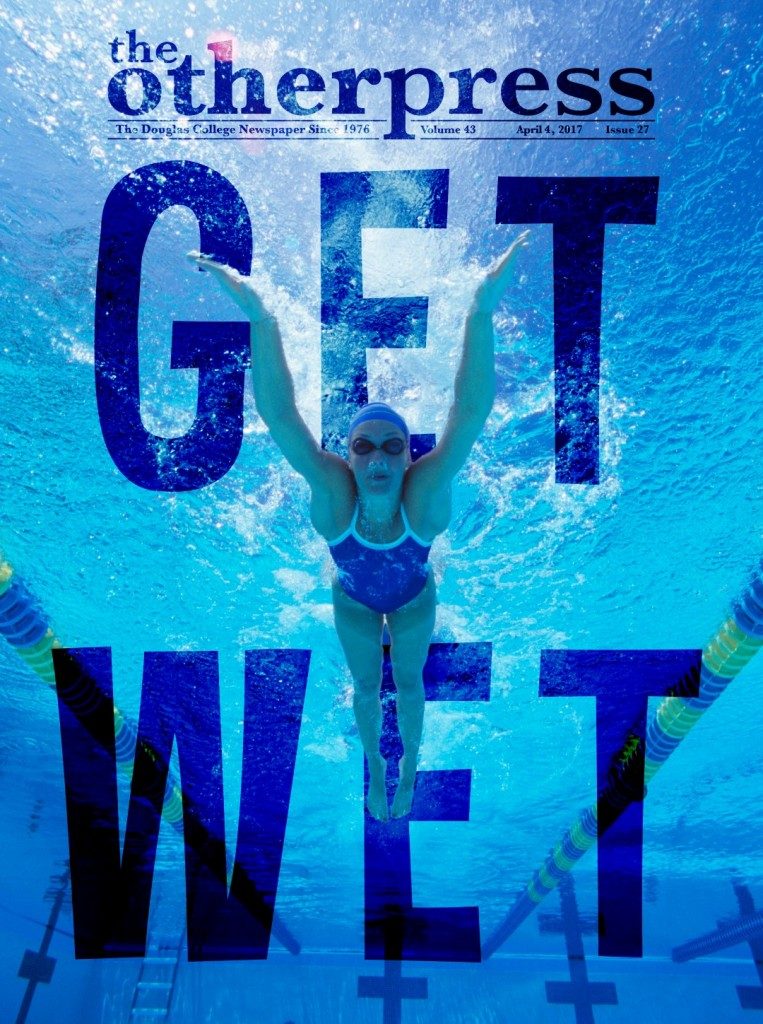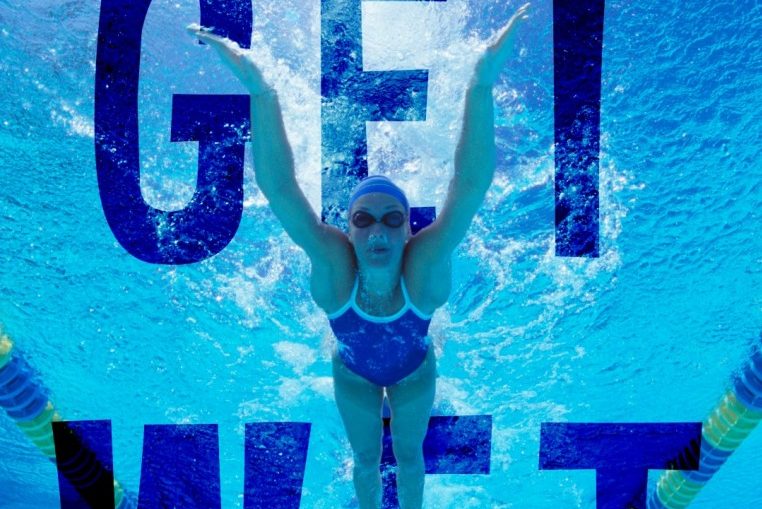
Splash, swim, and submerge
By Carlos Bilan, Staff Writer
Spring is here, which means that summer is just around the corner. Sounds like a good time to swim your heart out, if you ask me!
Did you know?
Swimming is considered one of the best sports for burning calories.
Calorie burn depends on your weight. According to Maclean’s, the average Canadian man weighs 187 pounds, while the average Canadian woman weighs 155 pounds. Taking this into account and referring to data from Nutristrategy, swimming laps of freestyle for an hour can burn up to 600 calories for the average man and 493 calories for the average woman. That is only for swimming freestyle laps at a slow and even pace, so if you swim fast or competitively, then you can expect the amount of calories burned to be even higher!
Types of strokes
There are four types of swimming strokes: freestyle, backstroke, breaststroke, and butterfly.
Freestyle and breaststroke burn the same number of calories. Backstroke burns less calories because it is a rather graceful stroke. Butterfly burns the most calories, and if you aren’t familiar with the stroke then you should definitely look up videos of it right now, because it is quite something to see.
Every swimmer has their best and preferred stroke. Personally, butterfly is my least favourite stroke to swim because it can really be tiring. However, when I want to show off my impressive skills in the pool it’s the flashiest one to do. Breaststroke is my favourite because I find it relaxing—even when I’m going all out. I’m also good with both backstroke and freestyle.
Want to swim competitively?
Don’t be intimidated. Remember that everyone in the pool started out as an amateur. No one is going to judge or make fun of you if you’re slow in the beginning and can’t quite keep up. Everyone is training to become better, so everyone is working towards their own personal goals. What really matters is that you swim your heart out, keep up with your own time, and do your very best. If you have that mindset, you will see your speed, form, and everything else improve dramatically as time goes on.
Attend training daily. It is absolutely crucial that you attend every training session. Missing one day of training is basically like taking two days off. You will feel noticeably slower than before. Swimming is a sport that requires continuous practice and training, so if you’re considering swimming competitively, you have to be sure this is what you really want.
Get your sleep. Every swimmer’s worst enemy is sleep deprivation. Many studies show that lack of sleep affects your athletic performance. In fact, if the optimal amount of sleep is 7 hours and 30 minutes, you’ll have to aim for 9 hours of sleep. I remembered a day when I only had 7 hours of sleep; when I went to swim, I was losing breath quickly and my kicks weren’t as strong. When I had a complete nine hours of sleep, I was in perfect shape and beating my personal bests.
Eat a lot. Now this may be a perk, actually! Have you heard of the Michael Phelps’ diet? In 2008, Phelps ate 12,000 calories a day to prepare for the Beijing Olympics. Now it sounds crazy, but there is a scientific reason behind it. You burn a lot of calories when swimming and your body will need just as much fuel to keep going. I can guarantee you that your appetite will increase tenfold once you start training—of course, not to a 12,000 calories a day, but around 3,500. I remember when I used to swim, I would eat thrice the amount as what I usually would eat, and there was a time I was so hungry that I took on a biggest burger challenge at a restaurant and finished it. Just make sure to rest for at least an hour after every meal before swimming!
Make friends! Having friends to swim with makes training an even more enjoyable experience. Swimming may be an individualistic sport by nature, but camaraderie can still take place, especially when you’re all in the same team and trained by the same coach. You all could be competing against each other during sprints, but at swim meets—and especially during relays—you’re all going to be working together.
Swim meets or swim competitions
Swim meets can be daunting. Competing with other swimmers can really increase nerves and make the pool appear bigger than it is. It also doesn’t help that you’ll be swimming a 50-metre distance, unlike the 25-metre distance you’ll probably be used to swimming during training. It may feel nerve-wracking, but this is completely natural.
What I did to help shake off the nerves was listen to music before swimming. If you watched the Rio Olympics or followed it on social media, you probably have seen the meme of Michael Phelps doing his “death glare” as he listened to music on his headphones. People assumed that he was angry towards another swimmer, but he clarified in the Today Show that he had the music and thoughts going through his head and that he was “in the zone.” Music can really help to calm your nerves, so listening to upbeat, energetic music will definitely get you pumped up for when you take your mark and dive into the water.
You should also remember to have fun. Honestly, my favourite part of the swimming experience was the training and exercise. Competition was a bonus, as it was a way to evaluate my swimming performance. Swim meets really put this to the test, so just do your very best and enjoy the cool rush.
Leisure swimming
Who said that swimming is only about the exercise and burning calories? Swimming can also be fun!
Nearly every city has an aquatic centre. Most have more than just a big pool dedicated to doing laps and swimming for exercise, as there are tons of other facilities aquatic centres offer to make your aquatic experience relaxing and fun.
Take a dip in the hot tub. Hot tubs have jets of bubbles blasting from underneath going up to the surface of the water, which can feel like a massage on your body. A dip in the hot tub is actually experiencing hydrotherapy, since the buoyancy, heat, and bubbles are working together to provide great benefits for your body. It soothes your muscles, relieves stress, and helps you feel relaxed, so immerse yourself in that bubbly feeling, close your eyes, and focus on the gentle sensation. Just remember to get in the water slowly, as it can be really hot and your body needs to be conditioned first.
Another way you can receive a hydrotherapeutic massage is sitting under the mushroom-shaped waterfalls, if that is something your aquatic centre has. The feeling of the water splashing down onto your body gives a gentle hammering sensation for your head, shoulders, and entire upper body, and the sound of the water splashing drowns out the sound around you, providing a meditative experience. If the nearby aquatic centre has one, you should definitely try it out.
Aquatic centres also tend to have a circular pool where the jets carry your body around in a current. It could be a dizzying experience for some, but for others it feels like a water carousel. Just let the water carry you away. You can even try sitting on a kickboard to “ride” the currents.
Do a big splash from the diving board. If you’re pumped with adrenaline, then go check out if the diving boards are open for business—or splashes. If they’re accessible and the lifeguards are letting people dive, then go ahead and climb that high ladder, take the flying leap of faith off the board, and dive down into the deep water. This section of the pool will definitely be deep, so make sure you know how to swim before trying it out.
Slide down the big slide. It isn’t swimming, but it’s definitely a must-do when you visit the aquatic centre!
Don’t know how to swim?
If you don’t know how to swim, then I strongly recommend taking up swimming lessons. Not only is it a great form of exercise, but it’s essential knowledge and a life-saving skill.
You could try to learn it yourself through the internet, but almost every swimmer has learned it from swim instructors or parents. It’s a practical skill, so the best way to learn it is through a coach teaching you. Trust me, it is an investment as well as an insurance. If an unfortunate event takes place and you happen to end up in a big body of water, then it is important to be able to save yourself by keeping your body afloat and swimming to the nearest dry land.
From personal experience, freestyle is the first and most standard swim stroke you will learn. When I took swimming lessons, the swim instructor made sure I do my freestyles correctly before proceeding to teach me the other three strokes, as they are considered more challenging than freestyle. Freestyle also comes first because back, breast, and fly are strokes mostly done only during competition.
I suggest you ask your swim instructor what they will be teaching you since swim programs can vary.
Final words
Swimming can be both a workout and a fun activity at the same time. It’s completely up to you which route you’d like to take. Swimming can definitely give the best of both worlds.
If you’re in it to win it, swim hard. If you’re just splashing in the water to have a good time, still remember to swim safe.
Now let’s go swimming! Race you to the pool!



